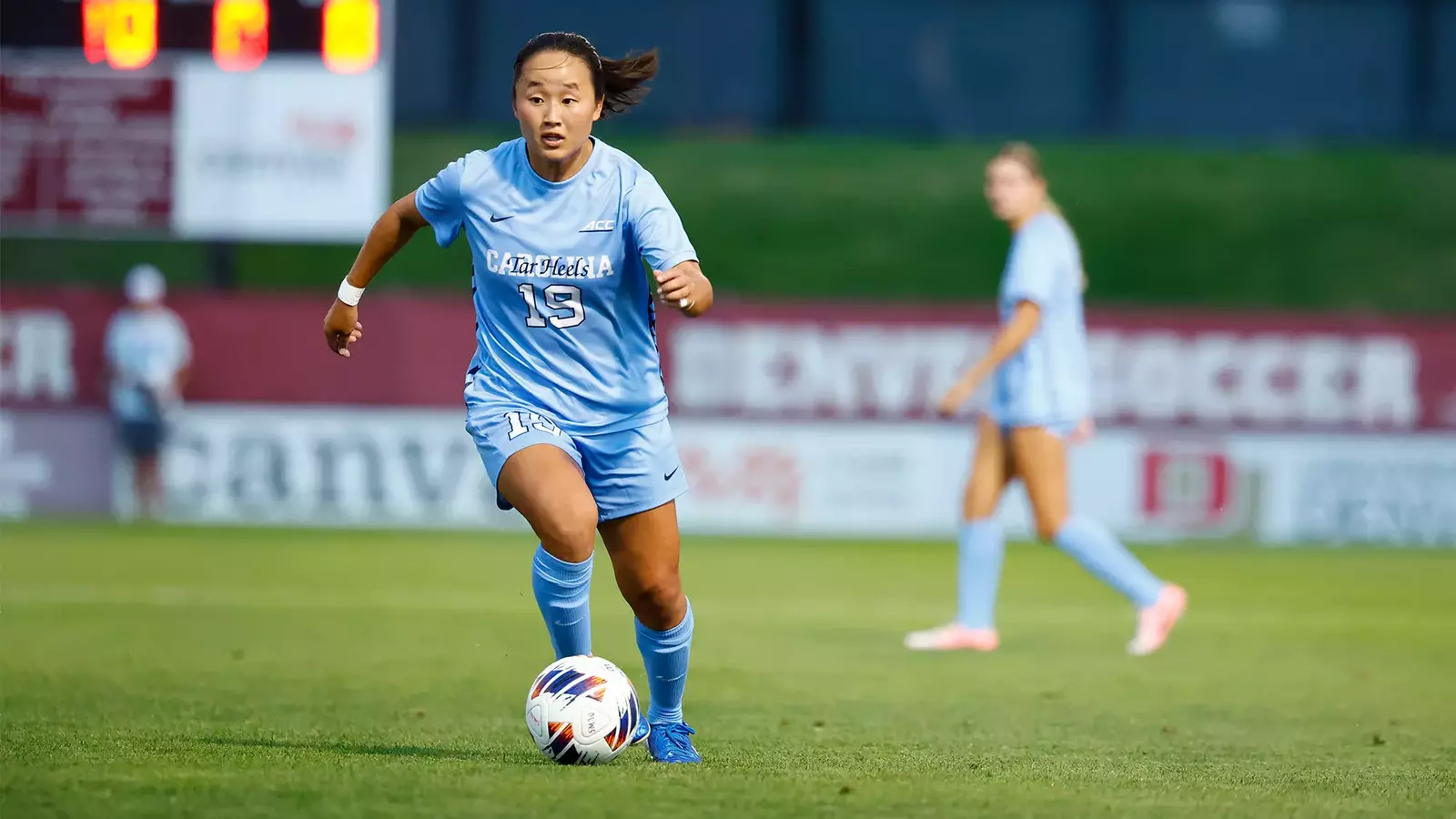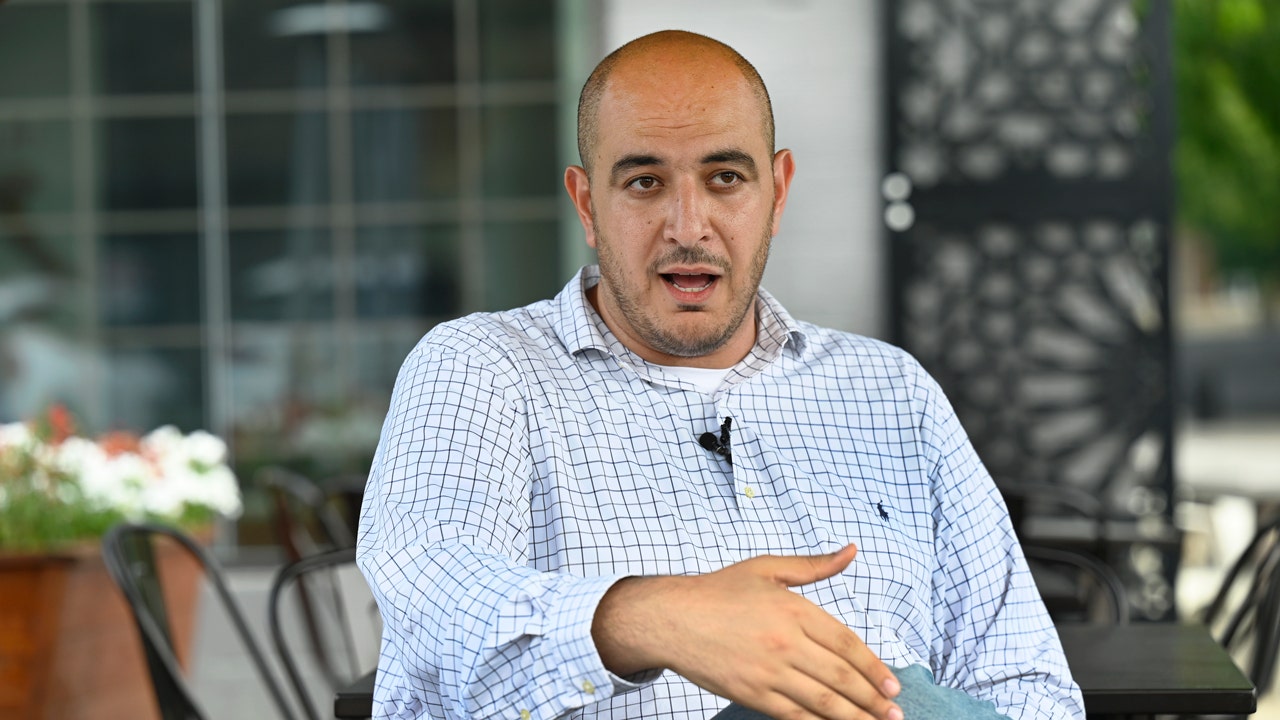Lifestyle
You go to this L.A. play. When you get there, you find out you have 60 minutes to escape

A few minutes after the play begins, the actors stop, empty their pockets and repeat their last few lines. And then they do it again. And again. And again. This live approximation of a vinyl record that catches on loop goes on for a few more minutes, the actors getting slightly louder and a tinge more testy as they continue the repetition.
They can’t move, they say, as they are “waiting for Godot.” But they are actually waiting for us, the audience, to get out of our seats, walk onstage and start to piece together a puzzle out of the fragmented pieces of paper they‘ve dropped.
Cards and letters lay on the ground for audience members to discover the next clue.
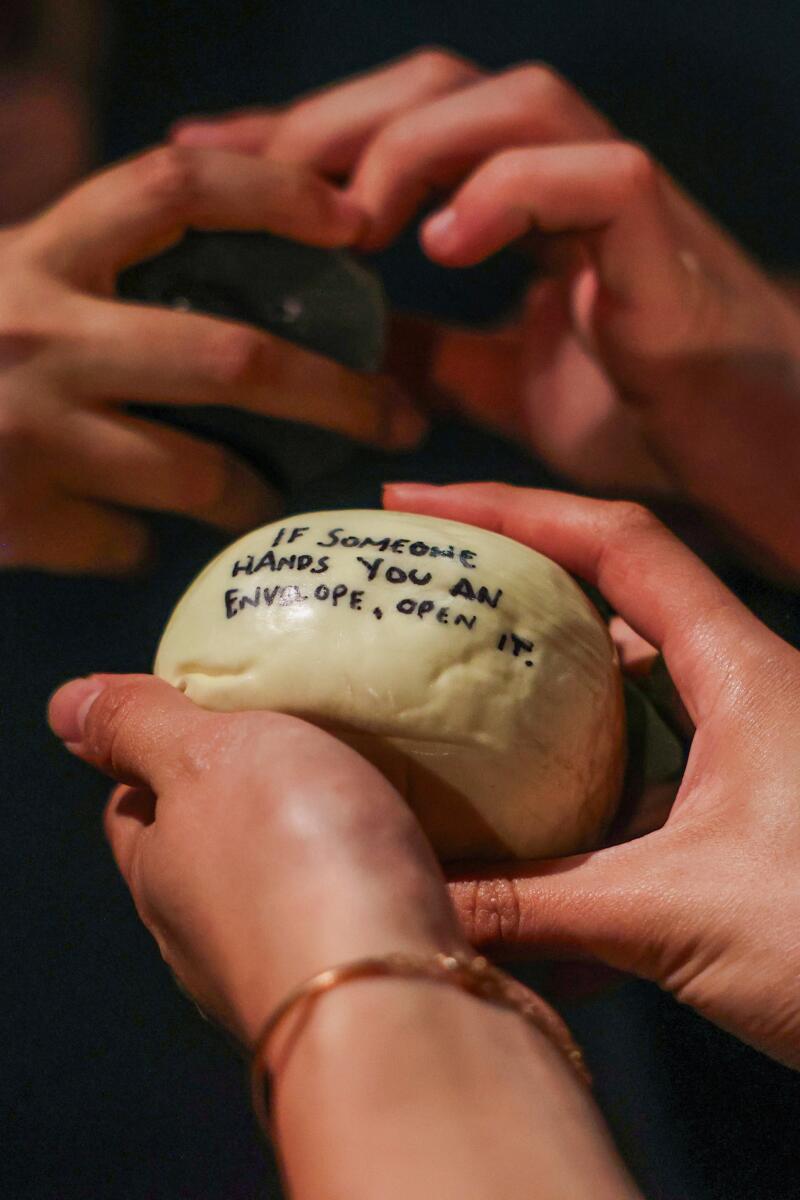
Melanie Pentecost holds a rock that gives the next context clue to to move the play forward.
This is “Escape From Godot,” an escape room that is also a work of theater — or vice versa. It upends the conventions of both. This is a play in which audience members become participants, the game requiring patrons to hop on the dials and interact with props in order to propel the narrative forward. Puzzles are hidden in the script, ensuring that the players become actors and are in abstract communication with the performers.
But its greatest trick? Inspired by Samuel Beckett’s “Waiting for Godot,” the theatrical escape room taps into the themes of the original work, creating an open-for-interpretation piece of playfully interactive art that grapples with existential questions — how we communicate, or fail to, with others, and the balance among selfish behavior, free will and empathy. Like Beckett’s play, there is no Godot who will come, but we are all caught in a world where the mundane, the absurd and our own desire for answers propel us forward.
Our group — I’m playing with seven strangers — hesitates to jump onstage and set the game afoot. It’s a break of decorum, both of theater protocol and personal boundaries. One player nervously scans his ticket, trying to find a missing clue, another flips through a notebook that was placed on her chair and most of us look at each other and whisper questions about what to do. Realizing, after about seven minutes, that there will be no end to “Escape From Godot” if we don’t move, my group begins to hesitatingly work together. In order for the actors to proceed to the next scene, we need to get them a message crafted from the ephemera that they have dropped.

Actor Phil Daddario kicks into the air during his performance.
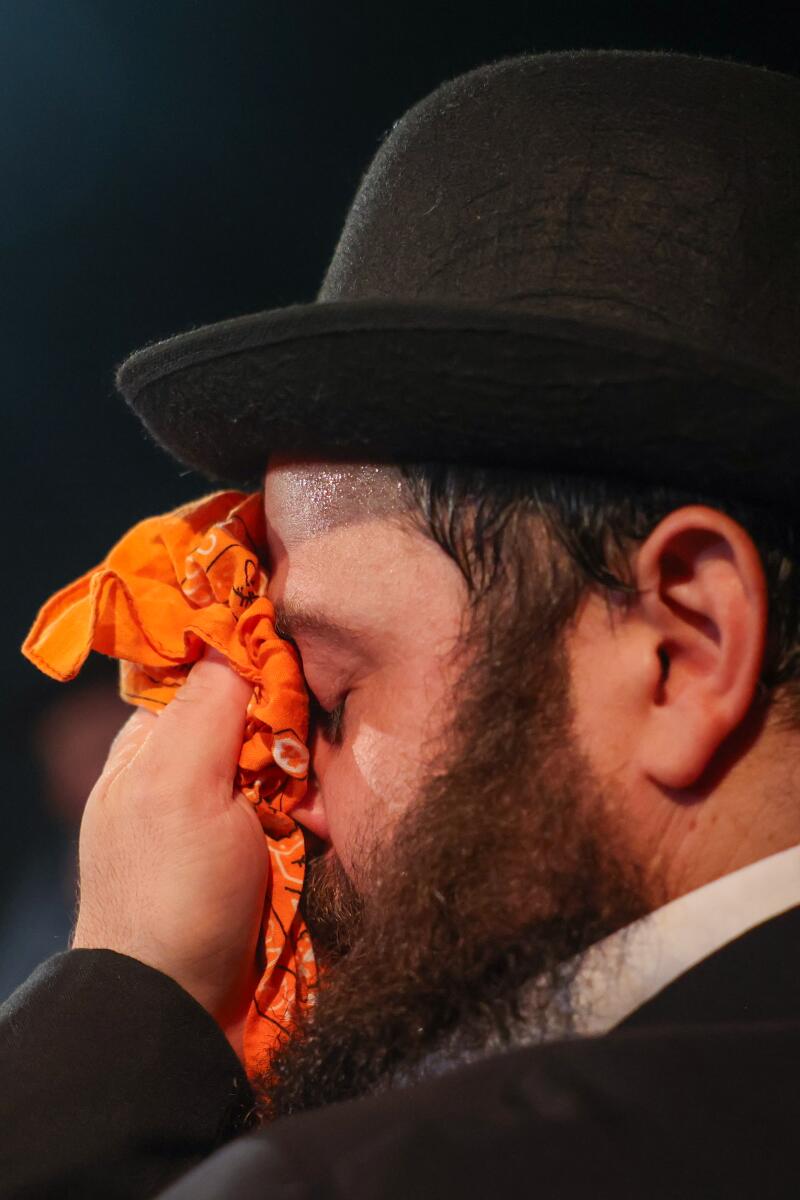
Daddario wipes sweat from his face while performing.
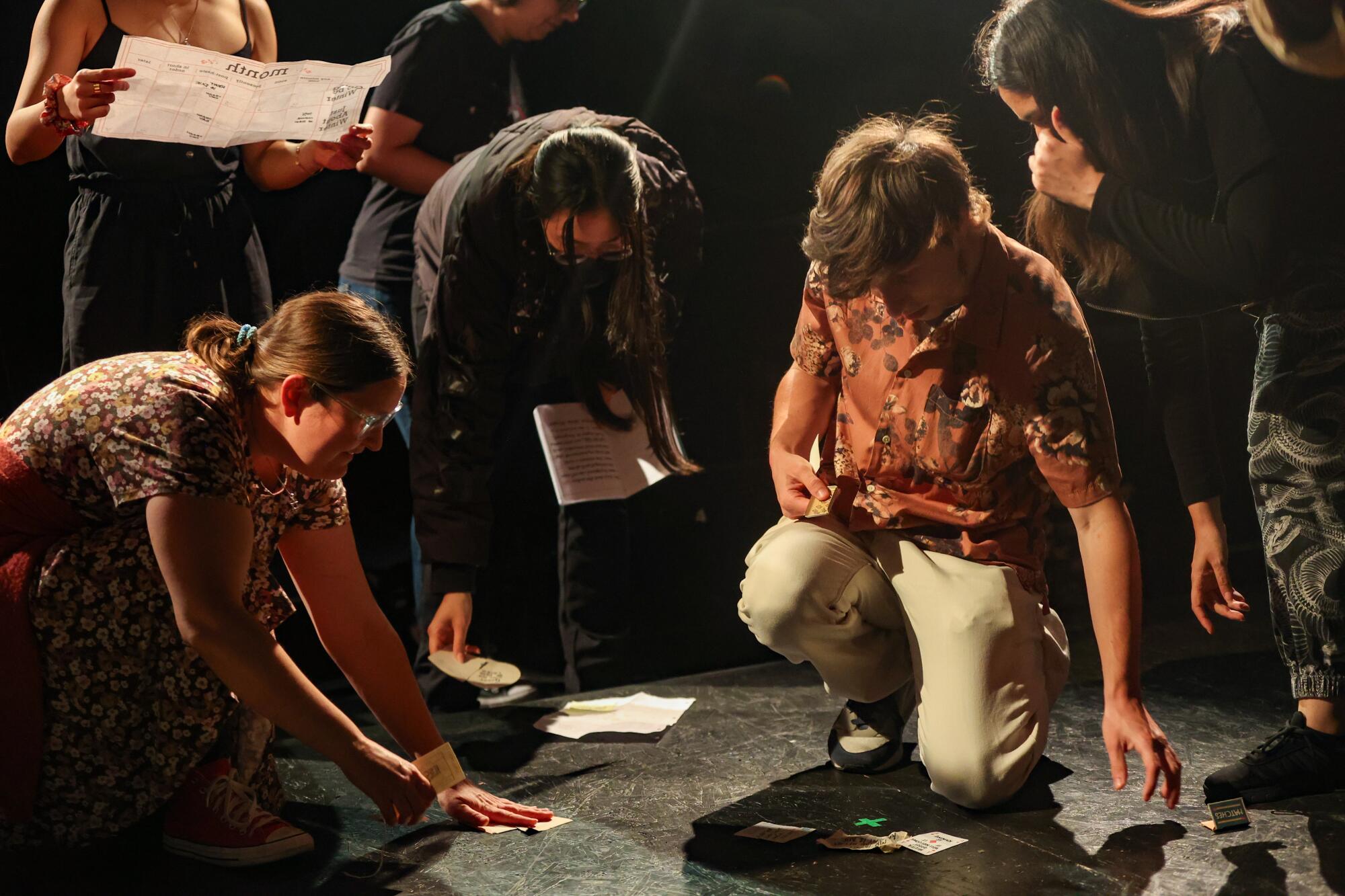
Audience members look on the ground for context clues to solve the next puzzle.
“I bet you were not the longest group that has sat,” the show’s co-creator, Jeff Crocker, later tells me when I describe those seven minutes of awkwardness. Jeff is one half of Mister & Mischief, an L.A.-based husband-and-wife duo that has crafted experiences for theme parks, zoos, museums and more. (Jeff’s wife, Andy Crocker, recently created a game-like experience for the Los Angeles Public Library system.) “Escape From Godot” is their first escape room.
“Typically, theater-minded folks, the last thing they’re ever going to do is get up onstage in the middle of the scene,” Jeff says. “That’s a hidden puzzle right there. Are you the person who is bold enough to walk onstage in the middle of a performance in order to make this repetition cease? There’s a lot of weird little social bits like that happening.”
“Escape From Godot” premiered at the Hollywood Fringe Festival in 2018 and has been periodically revived over the years, its latest as part of this months RECON event at the Universal City Hilton, a convention held by escape room aficionado site Room Escape Artist. An initial run of dates through Aug. 25 at Atwater’s Moving Arts Theatre sold out, so “Escape From Godot” has been extended through Sept. 8.
The idea stemmed from Crocker hearing about an escape room in Europe that had taken place throughout a train, a promotional event tied to a film. Joking about potential properties they could base a project on, the Crockers hit on “Waiting for Godot.”
“Andy has a theater degree, and ‘Waiting for Godot’ is classically known as this play where nothing happens,” Jeff says. “To folks who don’t create theater, you hear that as the B-word, boring. It’s a go-to play where people wait for a person who never shows up. There’s more to it than that, and when you see a not-great production of ‘Waiting for Godot,’ it can feel like you want to escape. I’ve seen really great productions of it, and there’s a reason it’s a classic.”
In “Escape From Godot,” puzzles may be hidden in the bowler hats of the performers. Do we ask them to surrender their apparel or wait in the hopes that they will drop them?

Actor Mason Conrad holds a large suitcase while performing in “Escape from Godot.”
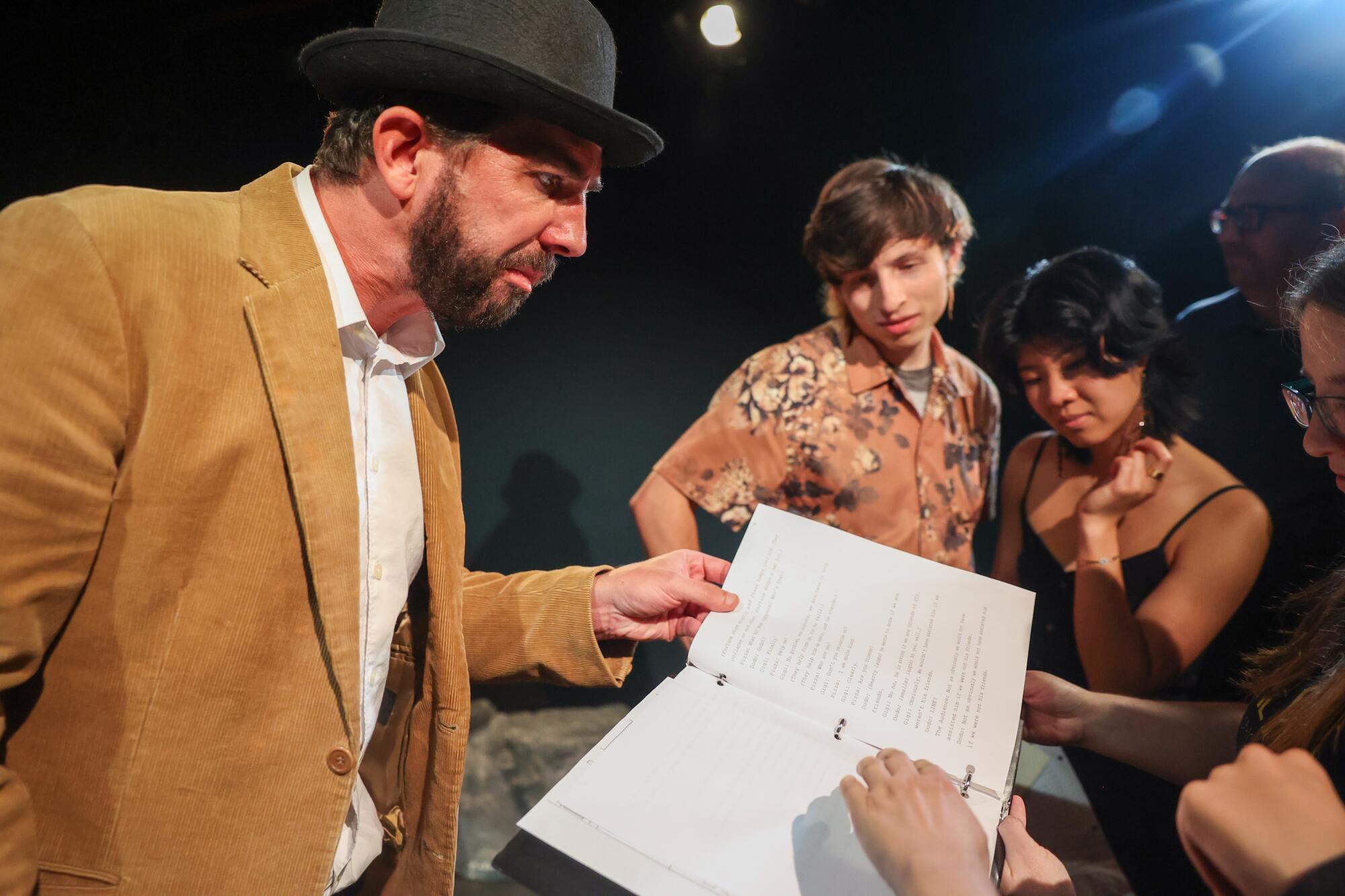
Actor Justin Okin looks through the stage play script for lines to give audience members context for the next clue.
Like Beckett’s play, characters in questionable physical shape will appear on the stage, but any sense of compassion is soon overtaken by the desire to solve the next puzzle via the props they‘re carrying. Boxes and baskets with locks may be dropped onstage, their combinations found in the monologues of the actors — Justin Okin as GiGi and Bill Salyers as DoDo, stand-ins for Beckett’s Vladimir and Estragon.
“Escape From Godot” will even nod to other theatrical works. My favorite puzzle turned out to involve a combination lock affixed to a basket, in which uncovering the solution required us to listen to a monologue that alluded to famous cats in history and culture. “Escape From Godot” won’t even start unless guests solve an initial puzzle, one the necessitates we align our tickets with a theater seating chart and find the correct seat. One could opt not to play, as long as others are, and sit and watch, taking in a script that toys with our place and faith in the world, albeit with a reference to the musical “Cats.”
The longer the audience goes without hitting on the right solution, the louder and faster the monologues will become. It creates tension and tests a group to maintain a sense of calm and patience. Nothing gets too hairy; the silliness of the situation dominates the tone.
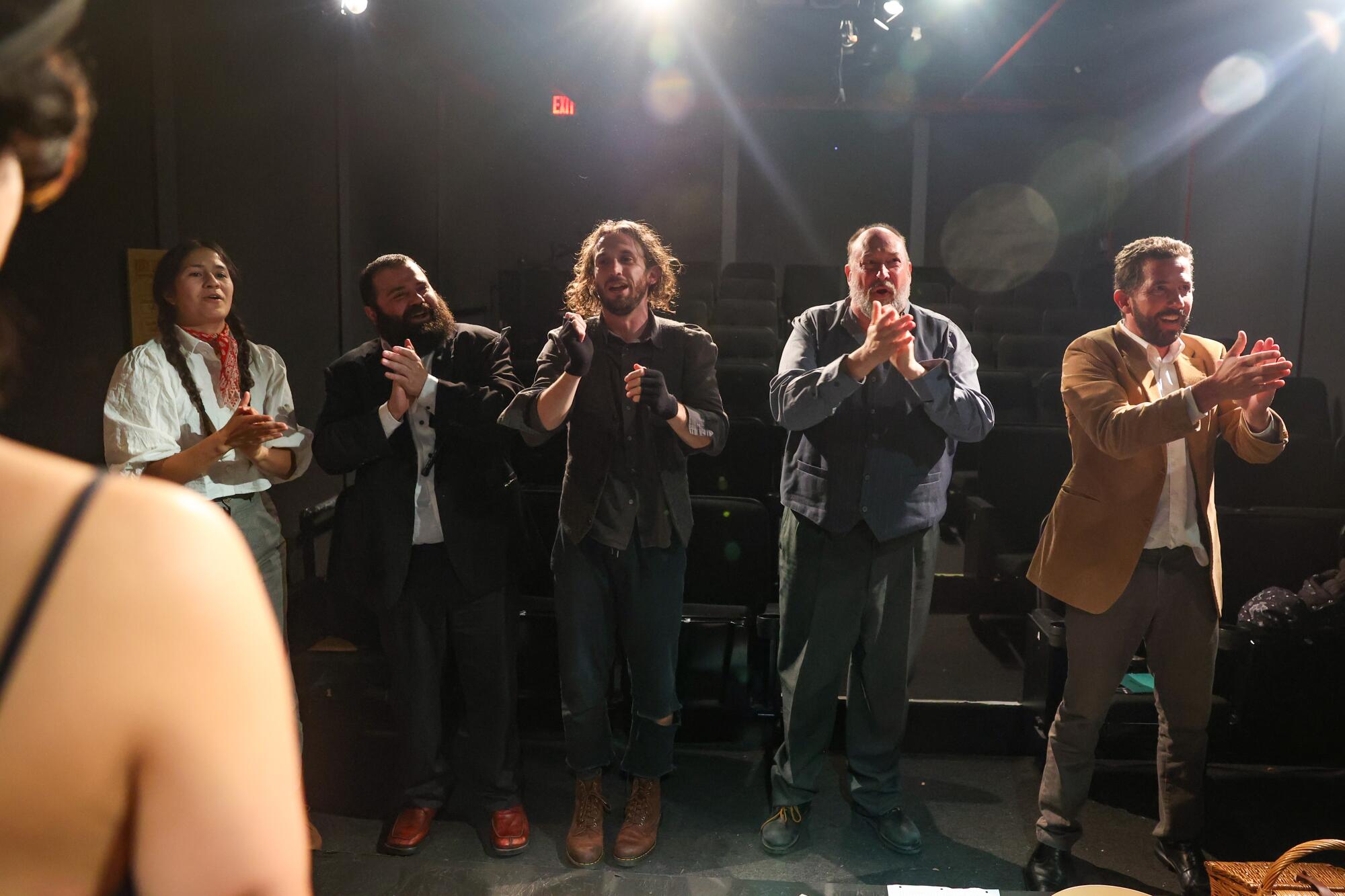
“Escape from Godot” actors applaud the audience at the end of the play, including, from left, Tiffany Ogburn, Phil Daddario, Mason Conrad, Bill Salyers and Justin Okin.
“We purely set out to fulfill our original delightful idea of having fun from escaping from a notoriously monotonous play, but in doing so, as we started to develop what the puzzles were and the way we wanted the audience to interact, it did start to support the themes of the play while also poking a little fun at it,” Jeff says. “You get the little bits of what Beckett was trying to say about what existence wants to be, what belief in God wants to be, but doing it in a way that is mischievous.”
By the time the show ends, roles have been reversed. Members of the audience have been cast as performers and the actors at times became the audience, trapped with repeating dramatic orations while watching us play. It’s a final message that isn’t too divorced from the Beckett text: We’re all performers, too often waiting for a cue.

Lifestyle
A death educator and a knitter walk into a cemetery — it's “Grieving & Weaving”

Death educator Gabrielle R. Gatto and artist Mary Pat Klein host “Grieving & Weaving” at The Green-Wood Cemetery on July 23, 2024.
Mengwen Cao for NPR
hide caption
toggle caption
Mengwen Cao for NPR
Late last year my dad was diagnosed with amyotrophic lateral sclerosis — or ALS — an objectively terrifying neurodegenerative disease. It’s progressive and fatal. It’s already taken my dad’s ability to talk and eat normally. There is no cure. When he told me about his diagnosis, I knew two things right away: I wanted to spend as much time with him as possible and if I was going to be living in my childhood home, I would need a hobby.
Enter: the granny square.
I’m not very crafty, but I do like textiles. My mom knits, but in her youth, she’d crocheted a granny square blanket and was game to re-learn how to do it. Meanwhile, my dad — who has a funny sense of humor — decided his coping mechanism would be binge-watching “Grey’s Anatomy.” Granny squares and Grey’s became the after dinner routine and soon I was churning out dozens of multicolored squares. And it felt like this project was, maybe, helping?

A selection of granny squares that Samantha Balaban crocheted this year
Samantha Balaban/NPR
hide caption
toggle caption
Samantha Balaban/NPR
“It’s incredibly meditative,” says Gabrielle Gatto, a death educator and Manager of Public Programs at Brooklyn’s Green-Wood Cemetery. “And that’s part of ritual. That’s part of really sitting with something.”
On a Tuesday evening, Gatto sets up a snack table inside the cemetery’s chapel, preparing for the start of her monthly interactive workshop, “Grieving & Weaving.”
“I think it was important to have that in the name as well,” she says, laughing a little at her rhyme. “The bold honesty of, hey, we are going to talk about grief. We are going to talk about death, dying and loss. But we’re also going to create happy memories together and eat a bunch of food and drink a bunch of things.”

Gabrielle R. Gatto, coordinator of public programs at The Green-Wood Cemetery. “We are going to talk about grief. We are going to talk about death, dying and loss. But we’re also going to create happy memories together,” Gatto says.
Mengwen Cao for NPR
hide caption
toggle caption
Mengwen Cao for NPR
Tess Rafferty is sitting in the front row, knitting a sweater vest out of beautiful copper-colored wool.
“It’s squishy, it sheds, it pills. But I love it. Smells like sheep,” she says.
It’s a project that had been sitting in her closet for months. Earlier this year, after both her grandmothers died, she lost what she calls the “knitting light” for a while. Rafferty, who is also a therapist, says she almost skipped the workshop to stay home with her dog, but she’s glad she didn’t — being here is therapeutic.
“We just don’t talk about death, right? Like death education,” she explains. “I think so much of what I struggle with, what my clients struggle with, is trying to ignore the awareness that we are not here forever. Staring that right in the face is empowering in a way.”
One thing to note — even though the series is called “Grieving & Weaving,“ you don’t have to be doing either to participate. Mary Pat Klein, who co-facilitates the event along with Gatto, says they’re just trying to create community.

Mary Pat Klein teachers beginners how to crochet at “Grieving & Weaving”
Mengwen Cao for NPR
hide caption
toggle caption
Mengwen Cao for NPR
“Recently somebody asked me — they embroidered, could they come? And it’s like, yes, please! So we’re trying to open it up. Just come and be creative,” she says.
Klein has been knitting since she was seven years old — she comes from a family of knitters and crafters — she brought quilting squares that her mom cut out long ago and she’s wearing an ivory-colored shawl her grandmother made for her decades ago. Klein is also a professional: she’s knitted items for Broadway and television productions.

Professional craftsperson Mary Pat Klein at The Green-Wood Cemetery. “We’re just trying to create community,” she says of the event series.
Mengwen Cao for NPR
hide caption
toggle caption
Mengwen Cao for NPR
They’ve turned the chapel into something like an art classroom. There’s a huge tub of donated yarn, as well as clay, colored pencils, markers, and books. Klein asks the people filling the pews for a show of hands — is anyone here to learn to knit? To crochet? Several people, including Virginia McLure, say they are.
McLure isn’t grieving a death — but she did recently get divorced — she says she’s grieving a time in her life that’s now over. “It’s a new chapter,” she says. “It’s exciting and sad. There’s a lot of like, trying to figure out what to do.” Klein teaches her the single crochet stitch — maybe this is something she’ll like to do.

Virginia McLure learns how to crochet from Mary Pat Klein. “I’m so pleased,” she said of her progress.
Mengwen Cao for NPR
hide caption
toggle caption
Mengwen Cao for NPR
Some people chat with their fiber friends, others keep to themselves. One attendee is putting the finishing touches on a beaded costume, another is making an ashtray out of clay, and someone else is embroidering a very elaborate dragon. Susan Refice didn’t know what she’d feel like doing, so she brought her entire bag of projects: a cotton and silk test swatch for a future sweater, a crocheted penguin head for her niece, and a blanket.
“When my partner’s mother died — she was a knitter and a crocheter — she had a ton of yarn,” Refice explains. “I raided her stash. So this is yarn that belonged to her.”
Nancy Jewell loved to create. Refice hadn’t even been going out with her partner for a year before Jewell made her a quilt. It has a patch on it that says: “For Susan from David’s mom.”
When Jewell went into a nursing home, Refice thought it would be nice to make her something. So she bought rainbow yarn and made her a shawl.

At “Grieving & Weaving,” any craft goes. Some people play with clay, embroider, quilt, draw with markers, and write on sticky notes.
Mengwen Cao for NPR
hide caption
toggle caption
Mengwen Cao for NPR
“It was like, her favorite thing before she passed away,” Refice remembers. “All the people in the nursing home said it looked like butterfly wings.” Refice plans to give the blanket she’s working on now to her partner, something to remember his mom by. And, she adds, there’s also something kind of nice about making something with his mother’s yarn.
“When I’m using her yarn, I think about her. And I think about what she was doing when she originally bought the yarn,” Refice explains. “That’s the nice thing when you make stuff for people, and you think about them, those memories are always going to be there.”
Death educator Gabrielle Gatto says, after all, it’s not the end product that’s the therapy. It’s the act of doing it.
“A big thing with grief is moving through it both mentally and physically,” Gatto says. “And that’s exactly what we do here. We bring something that is maybe heavy on our minds or our hearts. And then we work with our hands. We work with it, and we work together.”

Fiber friends laugh together at “Grieving & Weaving”
Mengwen Cao for NPR
hide caption
toggle caption
Mengwen Cao for NPR
I think she’s right. I’ve crocheted several finished blankets, and some unfinished blankets, over about 17 seasons of “Grey’s Anatomy.” But what I’ve loved the most is the ritual — having something to do with my hands, a quiet space for my brain: thinking about the people I’ll give my blankets to and the memories of all the nights I’ve gotten to spend on the couch, just being with my dad.
Lifestyle
How one pop band is trying to turn concertgoers into climate activists

AJR fans at Denver’s Ball Arena perform the wave on June 20, 2024.
Chloe Veltman/NPR
hide caption
toggle caption
Chloe Veltman/NPR
At Ball Arena in Denver, thousands of fans of the multi-platinum-selling indie pop group AJR do the wave. The vast, coordinated ripple as the concertgoers throw their arms up instantly unites the room.
It’s this type of mass, coordinated energy that AJR bassist and climate activist Adam Met wants to harness.
“Can we actually capture that power in the concert space and make use of it to get people to do something more?” said Met, who also runs the climate change research and advocacy non-profit Planet Reimagined.

Ryan Met, left, Jack Met, center, and Adam Met, right, of AJR at the 2019 Lollapalooza Festival in Chicago.
Amy Harris/Invision/AP
hide caption
toggle caption
Amy Harris/Invision/AP
AJR has been filling arenas across the country this summer on its Maybe Man tour with quirky-existential hits like “Bang!” “Burn the House Down” and “World’s Smallest Violin.”
Along the way, the band has also been collaborating with local nonprofits in each city to inspire concertgoers to take local, policy-based action to help reduce the impacts of human-caused climate change — right there in the arena.
Getting fans to do something more
According to data shared by Planet Reimagined and verified by its local nonprofit partners, concertgoers at AJR’s two Salt Lake City shows sent 625 letters and 77 handwritten postcards to Utah legislators calling on them to decrease the amount of water being diverted from the Great Salt Lake.

“In Phoenix, they sent more than 1,000 letters to the city council calling on them to recognize extreme heat as a climate emergency,” Met said. “In Chicago, 200 fans sent letters to Illinois legislators urging them to pass the Illinois clean jobs platform, which supports investments in building transportation and the grid.”
Those seem like tiny numbers. But they make an impact.
“So if 30, 40 or 50 people are in a live setting and they’re being encouraged to support a particular nonprofit’s agenda, and they all send emails at the same time, that is definitely going to get the attention of lawmakers because that’s unusual,” said Bradford Fitch, president and CEO of the non-partisan Congressional Management Foundation, which has done research on outreach to lawmakers. “That doesn’t happen very frequently.”
Artists for climate activism
A growing number of artists are working to educate ticket-buyers at concerts about human-driven climate change as part of a broader environmental movement in the music industry.
“We’re seeing more and more artists and venues and festival teams increasing their ambitions around sustainability overall,” said Lucy August-Perna, global head of sustainability for music events promoter and venue operator Live Nation.
Artists like Billie Eilish have discussed the issue on stage.
“Most of this show is being powered by solar right now,” Eilish said at last year’s Lollapalooza Festival in Chicago. “We really, really need to do a better job of protecting this [expletive] planet.”
Many other performers, like Dave Matthews Band, The 1975 and My Morning Jacket, are also inviting activist groups to share information at concert venues.
“We have tables where fans can learn about local climate organizations and basically just connect about climate and sustainability,” said Maggie Baird, who oversees Eilish’s climate and sustainability efforts. (She’s also the rock star’s mom.) “I think it’s really important that artists use their platforms. They have a unique gift, and they also have a unique responsibility.”
“Most of our partner tours have fan actions and things that they can do on site,” said Lara Seaver, director of touring and projects at Reverb, which works with touring artists such as Eilish and AJR on implementing their environmental efforts.
Seaver said what sets AJR’s engagement work apart to a degree is its consistency and depth. “In every single market, we have something very local and meaningful and impactful happening,” she said.
Assessing the impact
According to Planet Reimagined, around 12,000 audience members participated in climate-related civic actions during AJR’s tour, such as signing petitions, sending letters, leaving voicemails, registering to vote, making donations and volunteering. An additional 10,500 scanned QR codes and signed up for emails to learn more about an issue.
AJR’s Met said he felt confident they would be responsive: Ticket buyers for concerts and festivals featuring artists like Taylor Swift, Beyonce, Dave Matthews Band and many more were polled in the recent Planet Reimagined Amplify: How To Build A Fan Based Climate Movement study, undertaken in collaboration with Live Nation. The majority of respondents said they’d be open to not just learning about climate change, but also would be open to take climate-related actions at these events.
Met said the findings also highlight what artists should do to be effective at each stop on a tour, such as being relevant to the local community. “If it’s affecting them and their community personally, they’re so much more likely to take action,” Met said.
Met said the research also shows artists need to model those actions themselves. “Fans have this deep connection to artists,” Met said. “So there is so much more impact on fans if the artist says, ‘Will you join me in doing this?’ As opposed to, ‘Will you do this?’”
Putting research into practice

Chelsea Alexander and Bobbie Mooney of 350 Colorado were on site at an AJR concert in Denver to engage fans in supporting their phase-out fracking campaign
Chloe Veltman/NPR
hide caption
toggle caption
Chloe Veltman/NPR
In Denver, fans were able to use their phones to scan a QR code displayed on screen to support a local campaign aimed at getting an initiative on the 2026 Colorado state ballot to phase out new permits for fracking by 2030. A contentious issue in Colorado, the process is used to extract oil and gas. It generates wastewater and emits toxic pollutants and methane, which is a major source of planet-warming pollution. But it’s big business.
Meanwhile, out on the concourse, representatives from 350 Colorado, the local climate change nonprofit that’s running the campaign, chatted up fans.
350 Colorado’s Chelsea Alexander told AJR fan Robin Roston that the QR code, “takes you to a form that takes about 20 seconds to complete.”
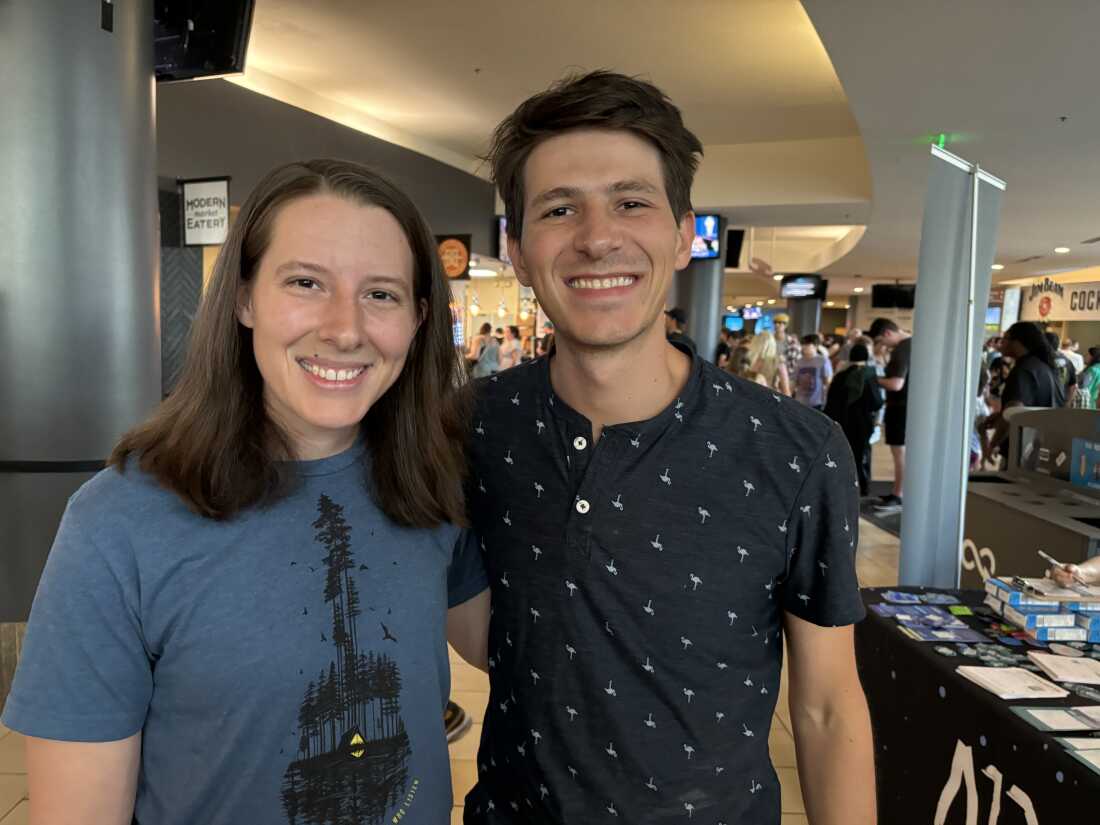
AJR concertgoers Robin Roston and Ben Roston
Chloe Veltman/NPR
hide caption
toggle caption
Chloe Veltman/NPR
“I think it’s a good way to get boots on the ground, chatting with real people who are here to enjoy music, and connecting that with helping the environment,” Roston said.
Small steps, big potential
According to 350 Colorado, 179 people took action over the course of AJR’s two performances in support of the phase-out fracking campaign. At least 125,000 physical signatures will be needed to get the initiative on the ballot in 2026.
But 350 Colorado representative Bobbie Mooney said every bit helps.
“We often think in terms of a ladder of engagement, where we can invite someone to take a small action and give them a sense of empowerment that they’re a part of the solution,” Mooney said. “And then we can invite them to take another, maybe greater action. They can join a committee, they can become a part of advocating for a particular bill in our legislature.”

Because of the collective energy they create, big, live gatherings such as concerts and sporting events provide a particularly powerful setting to get people on that ladder.
“The fact that everyone around us is doing something makes us dramatically more likely to do it ourselves,” said Cindy McPherson Frantz, a professor of psychology and environmental studies at Oberlin College.
But Frantz said it’s not easy for fans to sustain enthusiasm for such things after coming down off that big event high.
“You could get all excited about calling your senator or voting at the rock concert,” she said. “And then you go home, a week goes by or a month goes by, and you forgot all about it and you’re busy and whatever. And then it just completely evaporates.”
Frantz said simply getting fans to talk about climate change at a concert is a win, though. “The power of bringing people together and giving them the sense of, ‘I am not alone, I’m not the only person scared about this, I’m not the only person working on this problem,’ is a huge antidote to the hopelessness and the helplessness that comes from being isolated.”
Lifestyle
Skai Jackson Domestic Violence Case Rejected For Lack Of Evidence

Skai Jackson won’t face charges after her domestic battery arrest after fighting with her BF … ’cause prosecutors say there just isn’t enough evidence to bring the case to trial.
The L.A. County District Attorney’s Office tells TMZ … they’re declining to file charges because Skai has no criminal history, the alleged victim lacks injuries, and he’s refused to cooperate with prosecutors.

TMZ broke the story of the Disney Channel alum’s arrest … after cops say she was spotted getting into it with her BF last week at Universal CityWalk.
We’re told officers responded to the scene at CityWalk and security detained the couple after video showed Skai pushing her BF.
Cops say Skai and her BF both denied anything got physical — despite the video — and told officers they were happily engaged and expecting a baby.
Skai was still arrested for misdemeanor domestic battery, but she was released just a few hours later.
Good luck, kids.
-

 Ohio3 days ago
Ohio3 days agoOhio taxpayers sent families $966 million for private school tuition: Capitol Letter
-

 Politics1 week ago
Politics1 week agoKamala Harris shuts down anti-Israel protesters during campaign speech in Michigan: 'I'm speaking'
-
Finance1 week ago
Why stocks tumbled today
-

 Politics1 week ago
Politics1 week agoBlinken pressured to freeze Afghanistan aid after revelation nearly $300M could have gone to Taliban
-
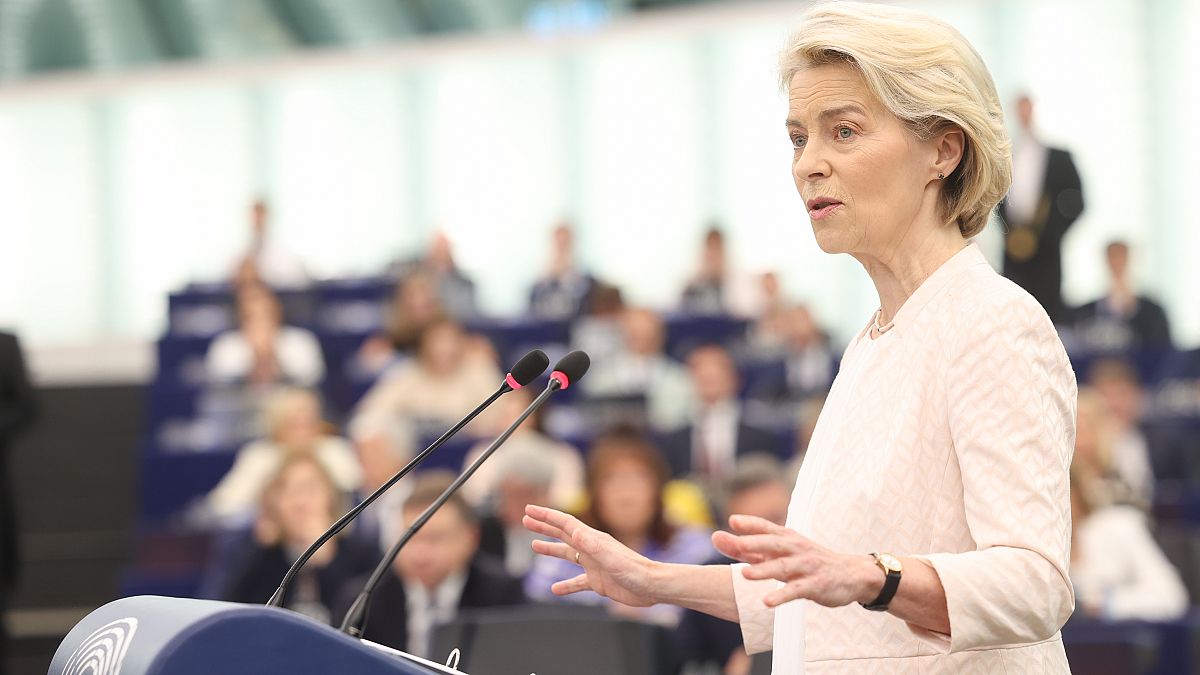
 World5 days ago
World5 days agoWhat could an EU Commissioner do to tackle the housing crisis?
-

 Movie Reviews1 week ago
Movie Reviews1 week ago‘It Ends With Us’: What the Critics Are Saying
-
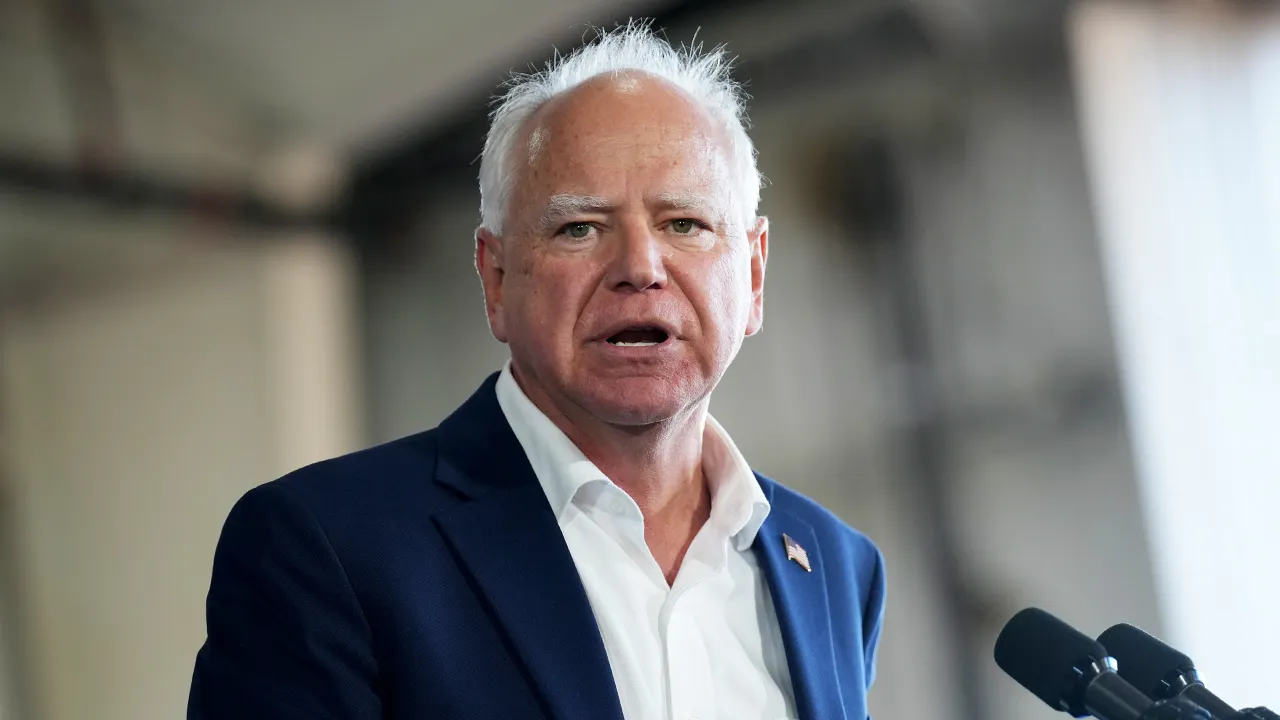
 Politics1 week ago
Politics1 week agoTim Walz 'misspoke' about using weapons ‘in war,' Harris campaign says: report
-

 Politics1 week ago
Politics1 week agoProgressive women's groups silent on second gentleman Doug Emhoff's affair



